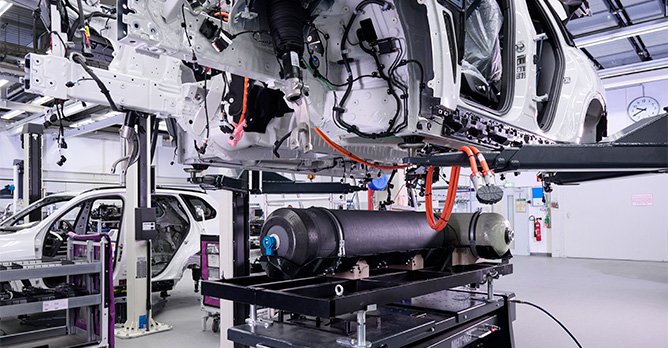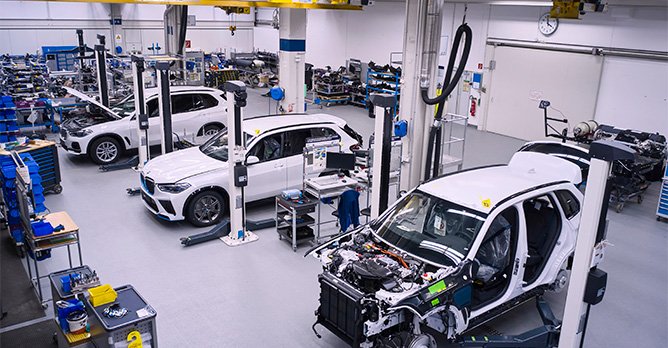BMW's iX5 Hydrogen pilot cars are finally hitting the road - but they won't be coming to Singapore
27 Feb 2023|1,547 views
The Belgian city of Antwerp isn't just significant to Europe because it houses the second-busiest port across the entire continent. It's also significant because it wants to take up a "leading position" as an "import hub for green hydrogen" within the region.
It was against this very backdrop that BMW rolled out the first vehicles of its pilot iX5 Hydrogen fleet to international members of the media, after four years of development.
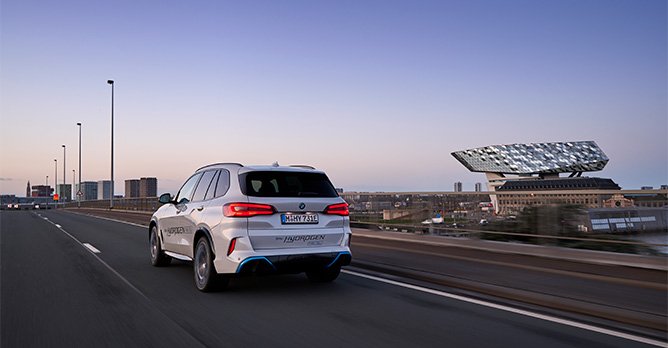
 The Antwerp 'launch' of the iX5 Hydrogen holds special meaning, as the city is shaping up to be an import hub for sustainably-sourced hydrogen The official word is that less than 100 units count to the fleet, and moving off from Antwerp, these will be taken on a global 'tour' as they continue to serve as demonstration and trial vehicles with a variety of target groups. BMW has confirmed that the car will not go on sale to the general public.
The Antwerp 'launch' of the iX5 Hydrogen holds special meaning, as the city is shaping up to be an import hub for sustainably-sourced hydrogen The official word is that less than 100 units count to the fleet, and moving off from Antwerp, these will be taken on a global 'tour' as they continue to serve as demonstration and trial vehicles with a variety of target groups. BMW has confirmed that the car will not go on sale to the general public.
You will want to know quickly that the hydrogen-powered SUV is built on the platform of the G05 BMW X5 - but utilises a fuel cell system housed at the front of the car in combination with a power battery at the rear (rather than a combustion engine) to power the car.
In essence, gaseous hydrogen from the car's tanks and oxygen from the air react in the fuel cells to produce water and electricity, allowing the fuel cell system to continuously produce 125kW (168bhp) on its own. BMW says this is the most powerful system of its kind for a passenger vehicle in the world.
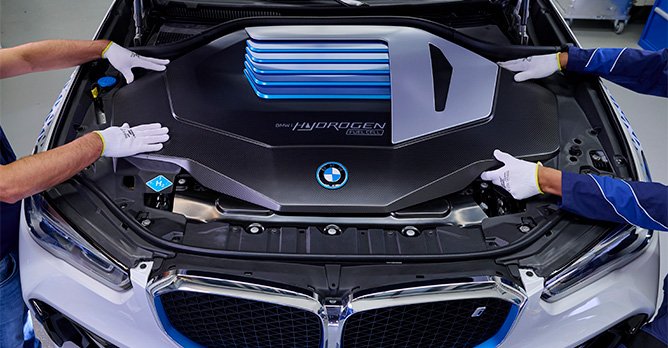
 While individual fuel cells are Toyota-sourced, the rest of the car's fuel cell system is built by BMW As part of its long-standing partnership with Toyota Motor Corp, BMW sources the individual fuel cells from the Japanese giant, but builds the fuel cell stack powering the car entirely on its own (and in a fittingly tech-y, highly automated process).
While individual fuel cells are Toyota-sourced, the rest of the car's fuel cell system is built by BMW As part of its long-standing partnership with Toyota Motor Corp, BMW sources the individual fuel cells from the Japanese giant, but builds the fuel cell stack powering the car entirely on its own (and in a fittingly tech-y, highly automated process).
A whopping 383 individual cells come together to form one fuel cell stack, which is then integrated into the fuel cell system alongside other components, such as a high-speed compressor and a high-voltage coolant pump, among others.
Interestingly, the iX5 Hydrogen uses the same electric motor on the BMW iX xDrive50 to send power to the car's rear axle, and in combination with a small power battery at the rear, maximum output for the drivetrain as a whole can reach 295kW (396bhp).
In effect - and to make things crystal clear - this also means the iX5 Hydrogen is also an EV, albeit a fuel cell EV (FCEV).
To accommodate its two carbon-fibre reinforced plastic (CFRP) hydrogen tanks, the iX5 Hydrogen also boasts a special floor assembly. The tanks are capable of storing up to 6kg of hydrogen at 700-bar, to give the car a WLTP-rated range of 504km.
Most importantly, however, the iX5 Hydrogen's two tanks will take just three to four minutes to refill, giving drivers the ability to cover long distances with just short stops in between.
Instead of being built at the BMW Group Plant Spartanburg alongside the marque's other X models (including the X5), or at Plant Dingolfing like the BMW iX, the iX5 Hydrogen calls Munich home instead. The vehicle is assembled at the Group's pilot plant, at its Research and Innovation Centre (FIZ).
The FIZ is also where every new model from its brands (including MINI and Rolls-Royce) is made for the first time, and employs 900 workers.
Sgcarmart was lucky enough to get some time behind the wheel of the iX5 Hydrogen, but the car has - sadly - not been slated for a Singapore stop in its pilot run. The answer as to why? It's straightforward, really: The island doesn't have any hydrogen refilling stations.
Nonetheless, a National Hydrogen Strategy was just announced in October 2022 by the Ministry of Trade and Industry, in which sustainably-sourced hydrogen is set to factor heavily in the nation's trek to decarbonisation by 2050.
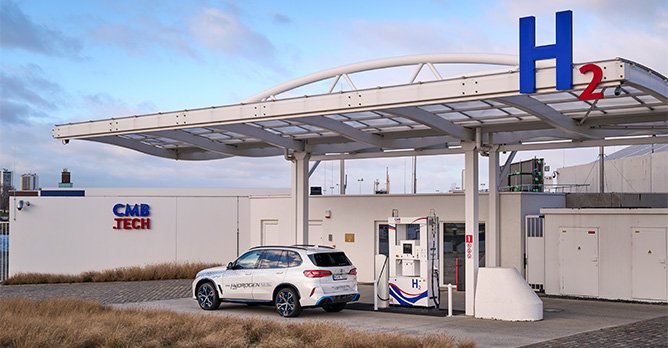
 BMW believes the iX5 Hydrogen comes at a vital moment in which hydrogen power is increasingly being acknowledged in the clean energy transition Singapore is not alone - and certainly not the quickest - in committing to a clean energy transition with hydrogen as a fundamental pillar, especially because of its relative ease of storage and transport. Major territories, including Japan, the U.S.A., and BMW's native Europe are increasingly recognising hydrogen power as a viable energy source.
BMW believes the iX5 Hydrogen comes at a vital moment in which hydrogen power is increasingly being acknowledged in the clean energy transition Singapore is not alone - and certainly not the quickest - in committing to a clean energy transition with hydrogen as a fundamental pillar, especially because of its relative ease of storage and transport. Major territories, including Japan, the U.S.A., and BMW's native Europe are increasingly recognising hydrogen power as a viable energy source.
Even as the BMW Group intensifies its electrification push (it sold 215,000 full BEVs in 2022), it is in light of the aforementioned developments that the firm believes that hydrogen fuel cell technology will become a pillar in its drivetrain portfolio towards emission-free mobility.
With the iX5 Hydrogen serving as a fully-formed taster, the firm has stated that it hopes to release a production series FCEV model in the later half of the decade.
It was against this very backdrop that BMW rolled out the first vehicles of its pilot iX5 Hydrogen fleet to international members of the media, after four years of development.

You will want to know quickly that the hydrogen-powered SUV is built on the platform of the G05 BMW X5 - but utilises a fuel cell system housed at the front of the car in combination with a power battery at the rear (rather than a combustion engine) to power the car.
In essence, gaseous hydrogen from the car's tanks and oxygen from the air react in the fuel cells to produce water and electricity, allowing the fuel cell system to continuously produce 125kW (168bhp) on its own. BMW says this is the most powerful system of its kind for a passenger vehicle in the world.

A whopping 383 individual cells come together to form one fuel cell stack, which is then integrated into the fuel cell system alongside other components, such as a high-speed compressor and a high-voltage coolant pump, among others.
Interestingly, the iX5 Hydrogen uses the same electric motor on the BMW iX xDrive50 to send power to the car's rear axle, and in combination with a small power battery at the rear, maximum output for the drivetrain as a whole can reach 295kW (396bhp).
In effect - and to make things crystal clear - this also means the iX5 Hydrogen is also an EV, albeit a fuel cell EV (FCEV).
To accommodate its two carbon-fibre reinforced plastic (CFRP) hydrogen tanks, the iX5 Hydrogen also boasts a special floor assembly. The tanks are capable of storing up to 6kg of hydrogen at 700-bar, to give the car a WLTP-rated range of 504km.
Most importantly, however, the iX5 Hydrogen's two tanks will take just three to four minutes to refill, giving drivers the ability to cover long distances with just short stops in between.
Instead of being built at the BMW Group Plant Spartanburg alongside the marque's other X models (including the X5), or at Plant Dingolfing like the BMW iX, the iX5 Hydrogen calls Munich home instead. The vehicle is assembled at the Group's pilot plant, at its Research and Innovation Centre (FIZ).
The FIZ is also where every new model from its brands (including MINI and Rolls-Royce) is made for the first time, and employs 900 workers.
Sgcarmart was lucky enough to get some time behind the wheel of the iX5 Hydrogen, but the car has - sadly - not been slated for a Singapore stop in its pilot run. The answer as to why? It's straightforward, really: The island doesn't have any hydrogen refilling stations.
Nonetheless, a National Hydrogen Strategy was just announced in October 2022 by the Ministry of Trade and Industry, in which sustainably-sourced hydrogen is set to factor heavily in the nation's trek to decarbonisation by 2050.

Even as the BMW Group intensifies its electrification push (it sold 215,000 full BEVs in 2022), it is in light of the aforementioned developments that the firm believes that hydrogen fuel cell technology will become a pillar in its drivetrain portfolio towards emission-free mobility.
With the iX5 Hydrogen serving as a fully-formed taster, the firm has stated that it hopes to release a production series FCEV model in the later half of the decade.
The Belgian city of Antwerp isn't just significant to Europe because it houses the second-busiest port across the entire continent. It's also significant because it wants to take up a "leading position" as an "import hub for green hydrogen" within the region.
It was against this very backdrop that BMW rolled out the first vehicles of its pilot iX5 Hydrogen fleet to international members of the media, after four years of development.

 The Antwerp 'launch' of the iX5 Hydrogen holds special meaning, as the city is shaping up to be an import hub for sustainably-sourced hydrogen The official word is that less than 100 units count to the fleet, and moving off from Antwerp, these will be taken on a global 'tour' as they continue to serve as demonstration and trial vehicles with a variety of target groups. BMW has confirmed that the car will not go on sale to the general public.
The Antwerp 'launch' of the iX5 Hydrogen holds special meaning, as the city is shaping up to be an import hub for sustainably-sourced hydrogen The official word is that less than 100 units count to the fleet, and moving off from Antwerp, these will be taken on a global 'tour' as they continue to serve as demonstration and trial vehicles with a variety of target groups. BMW has confirmed that the car will not go on sale to the general public.
You will want to know quickly that the hydrogen-powered SUV is built on the platform of the G05 BMW X5 - but utilises a fuel cell system housed at the front of the car in combination with a power battery at the rear (rather than a combustion engine) to power the car.
In essence, gaseous hydrogen from the car's tanks and oxygen from the air react in the fuel cells to produce water and electricity, allowing the fuel cell system to continuously produce 125kW (168bhp) on its own. BMW says this is the most powerful system of its kind for a passenger vehicle in the world.

 While individual fuel cells are Toyota-sourced, the rest of the car's fuel cell system is built by BMW As part of its long-standing partnership with Toyota Motor Corp, BMW sources the individual fuel cells from the Japanese giant, but builds the fuel cell stack powering the car entirely on its own (and in a fittingly tech-y, highly automated process).
While individual fuel cells are Toyota-sourced, the rest of the car's fuel cell system is built by BMW As part of its long-standing partnership with Toyota Motor Corp, BMW sources the individual fuel cells from the Japanese giant, but builds the fuel cell stack powering the car entirely on its own (and in a fittingly tech-y, highly automated process).
A whopping 383 individual cells come together to form one fuel cell stack, which is then integrated into the fuel cell system alongside other components, such as a high-speed compressor and a high-voltage coolant pump, among others.
Interestingly, the iX5 Hydrogen uses the same electric motor on the BMW iX xDrive50 to send power to the car's rear axle, and in combination with a small power battery at the rear, maximum output for the drivetrain as a whole can reach 295kW (396bhp).
In effect - and to make things crystal clear - this also means the iX5 Hydrogen is also an EV, albeit a fuel cell EV (FCEV).
To accommodate its two carbon-fibre reinforced plastic (CFRP) hydrogen tanks, the iX5 Hydrogen also boasts a special floor assembly. The tanks are capable of storing up to 6kg of hydrogen at 700-bar, to give the car a WLTP-rated range of 504km.
Most importantly, however, the iX5 Hydrogen's two tanks will take just three to four minutes to refill, giving drivers the ability to cover long distances with just short stops in between.
Instead of being built at the BMW Group Plant Spartanburg alongside the marque's other X models (including the X5), or at Plant Dingolfing like the BMW iX, the iX5 Hydrogen calls Munich home instead. The vehicle is assembled at the Group's pilot plant, at its Research and Innovation Centre (FIZ).
The FIZ is also where every new model from its brands (including MINI and Rolls-Royce) is made for the first time, and employs 900 workers.
Sgcarmart was lucky enough to get some time behind the wheel of the iX5 Hydrogen, but the car has - sadly - not been slated for a Singapore stop in its pilot run. The answer as to why? It's straightforward, really: The island doesn't have any hydrogen refilling stations.
Nonetheless, a National Hydrogen Strategy was just announced in October 2022 by the Ministry of Trade and Industry, in which sustainably-sourced hydrogen is set to factor heavily in the nation's trek to decarbonisation by 2050.

 BMW believes the iX5 Hydrogen comes at a vital moment in which hydrogen power is increasingly being acknowledged in the clean energy transition Singapore is not alone - and certainly not the quickest - in committing to a clean energy transition with hydrogen as a fundamental pillar, especially because of its relative ease of storage and transport. Major territories, including Japan, the U.S.A., and BMW's native Europe are increasingly recognising hydrogen power as a viable energy source.
BMW believes the iX5 Hydrogen comes at a vital moment in which hydrogen power is increasingly being acknowledged in the clean energy transition Singapore is not alone - and certainly not the quickest - in committing to a clean energy transition with hydrogen as a fundamental pillar, especially because of its relative ease of storage and transport. Major territories, including Japan, the U.S.A., and BMW's native Europe are increasingly recognising hydrogen power as a viable energy source.
Even as the BMW Group intensifies its electrification push (it sold 215,000 full BEVs in 2022), it is in light of the aforementioned developments that the firm believes that hydrogen fuel cell technology will become a pillar in its drivetrain portfolio towards emission-free mobility.
With the iX5 Hydrogen serving as a fully-formed taster, the firm has stated that it hopes to release a production series FCEV model in the later half of the decade.
It was against this very backdrop that BMW rolled out the first vehicles of its pilot iX5 Hydrogen fleet to international members of the media, after four years of development.

You will want to know quickly that the hydrogen-powered SUV is built on the platform of the G05 BMW X5 - but utilises a fuel cell system housed at the front of the car in combination with a power battery at the rear (rather than a combustion engine) to power the car.
In essence, gaseous hydrogen from the car's tanks and oxygen from the air react in the fuel cells to produce water and electricity, allowing the fuel cell system to continuously produce 125kW (168bhp) on its own. BMW says this is the most powerful system of its kind for a passenger vehicle in the world.

A whopping 383 individual cells come together to form one fuel cell stack, which is then integrated into the fuel cell system alongside other components, such as a high-speed compressor and a high-voltage coolant pump, among others.
Interestingly, the iX5 Hydrogen uses the same electric motor on the BMW iX xDrive50 to send power to the car's rear axle, and in combination with a small power battery at the rear, maximum output for the drivetrain as a whole can reach 295kW (396bhp).
In effect - and to make things crystal clear - this also means the iX5 Hydrogen is also an EV, albeit a fuel cell EV (FCEV).
To accommodate its two carbon-fibre reinforced plastic (CFRP) hydrogen tanks, the iX5 Hydrogen also boasts a special floor assembly. The tanks are capable of storing up to 6kg of hydrogen at 700-bar, to give the car a WLTP-rated range of 504km.
Most importantly, however, the iX5 Hydrogen's two tanks will take just three to four minutes to refill, giving drivers the ability to cover long distances with just short stops in between.
Instead of being built at the BMW Group Plant Spartanburg alongside the marque's other X models (including the X5), or at Plant Dingolfing like the BMW iX, the iX5 Hydrogen calls Munich home instead. The vehicle is assembled at the Group's pilot plant, at its Research and Innovation Centre (FIZ).
The FIZ is also where every new model from its brands (including MINI and Rolls-Royce) is made for the first time, and employs 900 workers.
Sgcarmart was lucky enough to get some time behind the wheel of the iX5 Hydrogen, but the car has - sadly - not been slated for a Singapore stop in its pilot run. The answer as to why? It's straightforward, really: The island doesn't have any hydrogen refilling stations.
Nonetheless, a National Hydrogen Strategy was just announced in October 2022 by the Ministry of Trade and Industry, in which sustainably-sourced hydrogen is set to factor heavily in the nation's trek to decarbonisation by 2050.

Even as the BMW Group intensifies its electrification push (it sold 215,000 full BEVs in 2022), it is in light of the aforementioned developments that the firm believes that hydrogen fuel cell technology will become a pillar in its drivetrain portfolio towards emission-free mobility.
With the iX5 Hydrogen serving as a fully-formed taster, the firm has stated that it hopes to release a production series FCEV model in the later half of the decade.
Latest COE Prices
November 2025 | 1st BIDDING
NEXT TENDER: 19 Nov 2025
CAT A$110,002
CAT B$115,001
CAT C$76,000
CAT E$121,010
View Full Results Thank You For Your Subscription.















